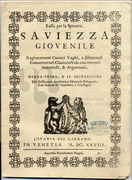Adriano Banchieri at 450
Monday, September 3, 2018

Tommaso Banchieri (1568-1624) is known today as having the first name Adriano, which he adopted in 1589 when he entered the Benedictine order, or more precisely the Olivetan order. He also used the pseudonyms Attabalibba dal Perù, Camillo Scaligeri della Fratta, and Il Dissonante.
Banchieri was active as an organist and composer in Bosco (near Bologna), Siena, Venice, and Verona. His writings on music theory reflect his experiences as a practicing musician. Banchieri played a significant role in founding the Accademia dei Floridi and was known as “Il Dissonante” in the Accademia dei Filomusici, its successor.
His first printed music editions were published beginning in 1596. Banchieri is considered one of the most important music theorists of the 17th century. His Organo suonarino (1605) and Conclusioni nel suono dell’organo (Bologna, 1609) describe the use of instrumental music during church services and describe, for example, the alternation between cantus planus and singing accompanied by organ. In his sacred and secular compositions, Banchieri placed particular emphasis on precise performance instructions. He was one of the first to use the terms piano and forte as a designation in the music. His madrigal books are like madrigal comedies. When sung successively, the compositions tell a story, and they are clearly rooted in the commedia dell’arte tradition.
The 239 records in the RISM catalog show the distribution of the sources today, which is more or less limited to Italian and German libraries. Thirteen of the editions can be viewed online.
Image: Title page to Saviezza giovenile, ragionamenti comici vaghi, e dilettevoli, Venezia 1628 (Museo internazionale e biblioteca della musica di Bologna (I-Bc) V.217; RISM ID no. 990003769).
Share Tweet EmailCategory: Musical anniversaries

